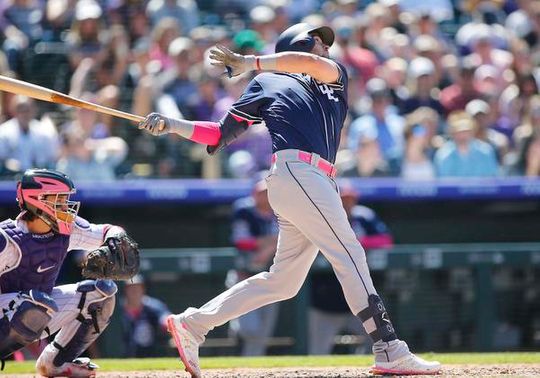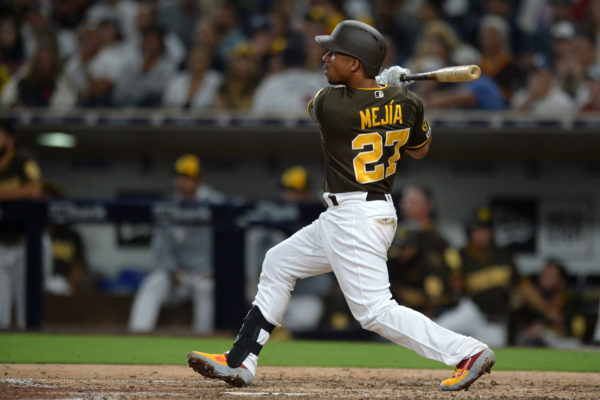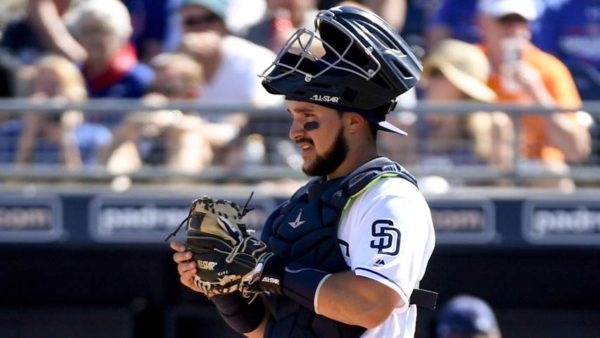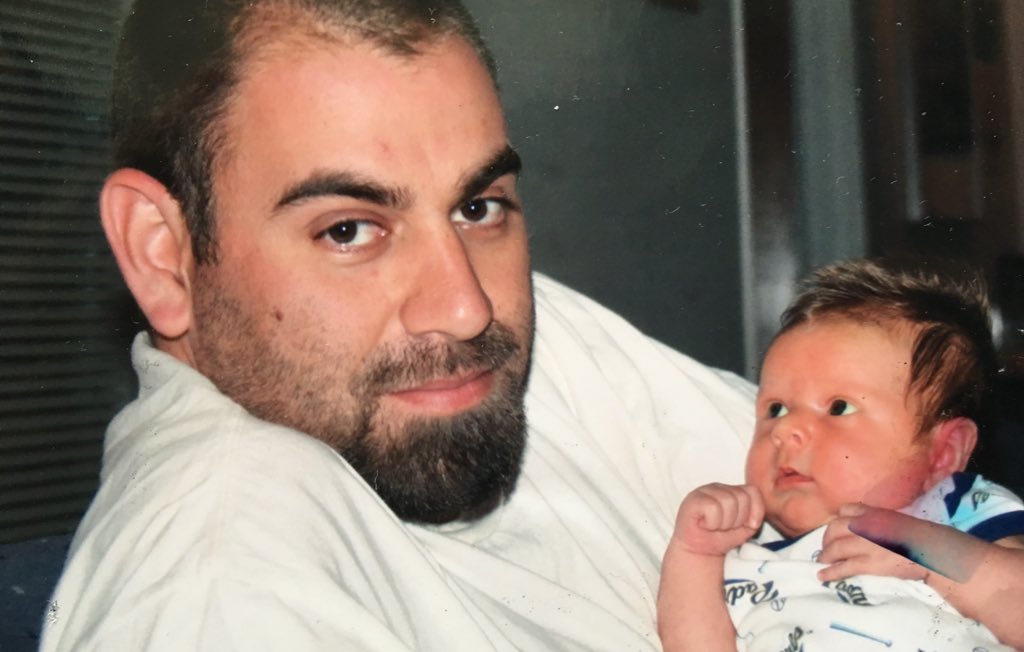Padres’ catching surplus will be addressed

Credit: USA Today Sports

With so much catching depth in the system, the San Diego Padres seem destined to make a move.
In Major League Baseball it is beneficial to have depth.
Presently, the San Diego Padres have an incredible amount of talent at the catcher’s position throughout the organization.
With three or four catchers who are Major League ready and a few more quickly developing behind them, there is a need for the Padres to make a move. The team has four men under the age of 27 with Major League experience. How many organizations can boast that about their catching crew? It seems pretty evident that the team will make a trade, and a catcher will be a part of the deal.
Let’s take a look at the Major League catchers as well as those in the system who are considered top prospects at the position.
Major League Level
The most experienced catcher on the roster, Hedges is a defensive wizard. The issue is that he simply cannot hit Major League pitching. Instead of getting better, he is falling further behind with the bat. Hedges’ swing is long, and he can get too pull happy. There is power in his bat, but the swing and miss factor to his game is simply inexcusable. Pitchers love to throw to Hedges as he does the little things to get the job done. If he can ever be just an average hitter, he could be a perennial All-Star. That is a big “if,” though.
The polar opposite of Hedges, Mejia is all bat and no glove. He has worked hard to improve in his defensive responsibilities, but will always be an offense-first catcher. Mejia has a rocket arm, arguably the strongest in the league, but he can get a bit reckless with his footwork. The framing aspect to his game also needs work. The switch-hitter can flat-out rake though and should have a long career in the majors on that fact alone. The Padres will hope the defense improves with this young backstop as he has a very high ceiling.

The left-handed-hitting Allen was considered an offensive-only catcher but has vastly improved with his receiving skills. The tall catcher has developed his framing skill and has also worked hard to be more consistent with his throws. Allen learned much from Austin Hedges this season about preparation and working with pitchers. He has excellent power and he shows a positive approach at the plate. The catcher has done all he can do in the minors and is ready for Major League action. It will be hard for him to get consistent playing time with the Padres, though.
Triple-A
This Venezuelan catcher has Major League experience and performed well the last two seasons in the minors. He is undoubtedly someone who is currently flying under the radar. Torrens is a player that you need to watch on an everyday basis to truly appreciate. The right-handed hitter has a compact swing and some power to his swing. Defensively, he receives the ball well and possesses a strong throwing arm. The 23-year-old works well with pitchers from all walks of life, showcasing excellent baseball communication skills.
Double-A
2019 was a coming-out party for Campusano as he gained national recognition. The right-handed hitter recorded a .906 OPS in 110 games in the Cal League. He was named an All-Star and is still only 21-years-old. Campusano has an excellent defensive profile, as he is not afraid to throw behind runners where he shows a plus arm. The power is coming from the stocky catcher as he gets older. The former 2nd-round pick has demonstrated the ability to make contact and displays a plus eye at the plate. There is a lot of upside with Campusano.

High Single-A
Regarded for his defense, Blake Hunt is starting to swing the bat much better. The right-handed hitter is working to calm his swing and get the most out of his ability. He generally makes contact but is striving to drive the ball up the middle more. Hunt is a tremendous defender and communicator behind the plate. He works well with his pitchers and does a great job of keeping his scouting reports in order. Hunt is still only 21, and will likely get better with time. He provides the team with even more depth at the position.
Low Single-A
22-year-old Logan Driscoll may settle in the outfield or first base when it is all said and done, but he is still regarded as a catcher. The left-handed hitter shows a fluid swing that is generally quick. There is not a lot of power in his bat, but that could come in time. Though he will never be a huge home run threat. Defensively, there are issues with his footwork and questions if he will stick at the catcher’s position moving forward.
Like Driscoll, this 22-year-old is playing multiple positions. He has a left-handed swing that generates gap power. The issue with Gatewood is his defense and the fact he has a below-average arm. He has played a lot of first base for the Padres, but could still return to the team as a catching prospect. A lot has to happen for Gatewood to move forward behind the plate, but there is still time. For now, he will occasionally catch while getting at-bats at DH or first base. Playing in the outfield is not an option for him.
With all this catching depth, it seems likely that the Padres will make a move. I would expect someone from the higher minor league level to be dealt this winter. Austin Allen or even Luis Torrens seem likely. A.J. Preller has done well to stockpile catching depth, and you can be sure he will get top-dollar when it comes time to move a prospect. This hectic winter should start very soon as the Padres search for relevancy in a very competitive NL West.

James was born and raised in America’s Finest City. He is a passionate baseball fan with even more passion towards his hometown Padres. James has written about the Padres and their prospects for over a decade. He also writes about San Diego State as well as other local sports. James is the Editor-In-Chief of EastVillageTimes.com. Always striving to bring you the highest quality in San Diego Sports News. Original content, with original ideas, that’s our motto. Enjoy.
I m going to have to disagree. I had been thinking we needed to add a high level catcher, but one key stat is changing my mind: contact rate. Francisco Mejia ranks 22nd of MLB catchers with at least 190 ABs (@75.2%) while Austin Hedges isn’t even in the top 50 catchers regardless of ABs. Mejia is ahead of Yasmani Grandal (72.9%) and under 2% behind JT Realmuto. It’s still a full 20% worse than leader, Austidillo from Minnesota. Guess who finished 1 & 2 in 2019 as a team? Nationals and Astros. It’s not hard to see that the adage “put the ball in play and good things will happen” is not how we’ve been approaching roster construction. Out of every 10 ABs, Minnesota has 2 more chances than we do at a flare, a bobble, an errant throw, or a bad hop. However, I think Mejia’s hit tool, age/experience, and a renewed emphasis on development within the organization make me say we need to keep Mejia as starter, Hedges as the perfect late inning double switch for defense, AND Allen as a third catcher/first basemen/DH on the Major league roster. This is a talented, somewhat-proven, cost effective position with a potential superstar in the system. Torrens could be dealt if a valuable piece would come in return. A year will tell us a lot, but our catchers need to have a better eye, worry less about home runs, and raise their contact rate.
Hosmer is 23rd among first basemen with at least 200 ABs, a full 15% off leader Gurriel. Kinsler was 22nd (79%) at second with Urias not only not on the list but behind teammates, France and Garcia. Kinsler, a DFA candidate, is a full 12% off the pace of Arraez of Minnesota. Minnesota won 100+ games. Contact rate gets wins. Home run or strikeout gets you boring losses on the regular with a handful of dramatic wins. At SS, Luis Urias is 27th with 74% while Tatis, Jr. didn’t make the list (requiring a contact rate of only 68.2%). Imagine what he’ll be like when he gets a League average contact rate! Andrelton Simmons led baseball at 90.2% for SS.
At third base, Machado has 78.2%, and is 19th at his position, a distant cry from third baseman, Hanser Alberto of Baltimore. at 90.5%. Alberto translated that into a .305 BA with 12 home runs on 160 hits in 139 games as a first year starter. Imagine if Machado was even halfway to him at 84%.
In left field, Josh Naylor at only 74.7%. Michael Brantley led baseball at 88% in left field. In center, 85.4% (Kevin Pillar) is the closest we get by position to the game’s leader as Manny Margot is at 77.9% a which is good for 10th of all qualifiers. I see some sites project Franchy there, but as much as I drool over his power/speed combo, I doubt his contact rate exceeds this. In right, like Hedges at catcher, we don’t register in the top 50 at the position. Renfroe is a great defender with great power and better yet, he has been clutch versus great pitchers. But, the refrain to attend to is simple: our offense on rough average is behind the better contact rates in the game at almost every position by 15%. A little louder for those in the back, that means more strikeouts, far fewer chances per rounds through the lineup to get the “Texas League bleeder”, seeing eye single, bobble, errant throw, etc. And, it allows pitchers to pitch deeper into games as 1.5 out of 10 other ABs, they’ll have to throw to another hitter.
The question is how do you respond. Is it the talent? Is it the instruction? Is it game management? Regardless, it is clear that both pennant winners understand that baseball hasn’t really changed over time very much. The home run is important, and some analytic will show it’s your greatest run producer maybe. However, winning baseball especially winning playoff baseball, to anyone who has played or coached (as opposed to the stereotypical stat feel), is about team offense putting pressure on team defense.
I’m not going to pretend to know roster construction from my my phone in my home in Iowa, but it’s really obvious that there is a connection between contact rate and wins when Washington (WS champs), Houston (AL champs), and Minnesota AL Central champs) seem to dominate the top 4 or 5 slots at almost every position. I’d be finding out who their hitting instructors and coaches are and seeing how we can apply their tenets to our system. And, if we’re already utilizing those essential instructions but not executing them in games (i.e., guys swinging for the fences against the wishes of the staff), then a better communicator is needed. Lastly, you look at player capabilities. If we’ve just amassed a bunch of bombers who have never been scouted as hit tool freaks, it may be time to discuss where changes are needed.
I’m not trying to win an article on here. I have been a fan of the brown and gold since 1984. I saw Tony Gwynn during their playoff ryn, and have been diehard ever since, which puts my decision making in question to begin with. I just want a “Braves-like” 20 year window where we are playing for a title run virtually every season. I’ll take my chances that we win more than one. I play pocket GM whenever I have free time and would love to assist the front office. It is a passion. Tell me if you think my confusions in this post are useful, off base, etc. Go Padres!
There is also an international player who is a catcher with a lot of potential going forward. The one thing that worries me about Mejia is that his ERA with the Pitchers is a lot higher than Hedges is. I would try to use Mejia in the outfield more, or maybe even at second base. Trade Austin Allen, keep Torrens at AAA for insurance and continue with the Hedges/Mejia experiment.